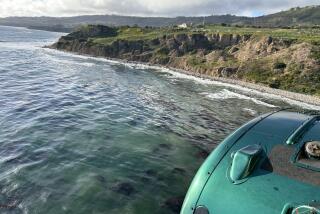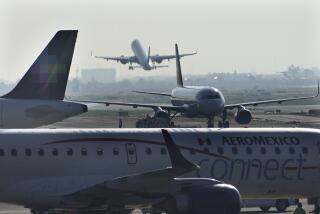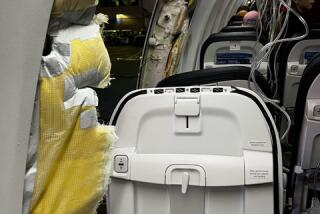‘The right guy at the right time’
It was just a few minutes after takeoff. The voice that came over the intercom was urgent but calm.
“Brace for impact,” Capt. Chesley B. “Sully” Sullenberger III, 57, told the 150 passengers of US Airways Flight 1549.
A veteran commercial pilot who flew fighter jets for the Air Force, Sullenberger pulled off a feat Thursday that drew grateful kudos from high-ranking government officials and the passengers aboard the Airbus A320: safely bringing his plane down onto the icy, 65-foot-deep waters of the Hudson River.
By all early accounts, Sullenberger’s deft maneuvering helped turn a potentially catastrophic situation into one remarkable for its lack of casualties.
After setting the aircraft down in one piece, the captain made two passes up and down the aisle to ensure that all of the passengers were off, then allowed rescuers to pluck him off the sinking plane.
Aviation experts said they could not recall another successful controlled water landing by a commercial airliner in the U.S.
New York Mayor Michael R. Bloomberg dubbed the captain’s work “masterful.”
New York Gov. David A. Paterson proclaimed Sullenberger heroic and called the incident “a miracle on the Hudson,” a moniker immediately taken up by the media.
“Thank the Lord and thank the pilot,” passenger Alberto Panero told CNN. “I can’t believe he somehow managed to land that plane safely.”
It would be difficult to find a pilot who had better credentials to handle the unusual emergency that faced Flight 1549, which apparently hit a flock of Canada geese shortly after taking off from New York’s LaGuardia Airport.
Sullenberger, who lives in Danville, Calif., has more than 40 years of flying experience, the last 29 as a captain with US Airways.
He has served as a local safety chairman and accident investigator for the Air Line Pilots Assn., International, according to his resume.
He also is a certified glider pilot, CNN reported, which may have helped him bring the Airbus down gently onto the river.
Before his work as a commercial pilot, Sullenberger had a short but distinguished military career.
He flew an F-4 fighter, a Vietnam-era jet that is notoriously difficult to handle compared with modern aircraft. He was also a mission commander for Red Flag combat training exercises, a coveted position usually assigned to the top pilots.
“He is the consummate pilot,” his wife, Lorraine, told the New York Post.
Frank Salzmann, one of Sullenberger’s neighbors in Danville, a suburb east of San Francisco, said he was not at all surprised to hear Sullenberger was the pilot who landed the US Airways jet safely, calling him a “very calm, in-control and in-charge type.”
“When you think of a captain of an airline, you pretty much think of Sully,” said Salzmann, 45, a software engineer.
“It was just the right guy at the right time and at the right moment,” added neighbor Jim Walberg. “Everybody is so proud and grateful and relieved.”
He noted that Sullenberger, a humble man, would probably chafe at being called a hero.
“It’s a name he will not take very easily,” Walberg said.
In addition to Sullenberger’s “passion for flying,” the pilot and his family are involved in community service, working at food banks, raising dogs for the blind and doing walks for cancer research, Salzmann said.
Sullenberger and his wife, who have two teenage daughters, moved to their upscale Danville neighborhood about 11 years ago.
Two years ago, Sullenberger founded Safety Reliability Methods Inc., an aviation safety consulting firm based in the Bay Area.
Sullenberger lists on his resume several achievements in aviation safety, including identifying and helping to correct hundreds of Federal Aviation Administration instrument landing system procedures.
Karlene Roberts, director of UC Berkeley’s Center for Catastrophic Risk Management, said she met Sullenberger two years ago when he contacted her about the center’s work in reliability enhancement.
Roberts called him a pilot who was “at the top of his game.”
On Thursday night, as his jet lay submerged in the frigid Hudson River, anchored at the southern tip of Manhattan, aviation experts said Sullenberger pulled off a maneuver so rare that pilots weren’t taught how to execute it.
He faced an exceedingly unusual scenario: Although pilots often have to contend with what they call a “bird strike,” it is uncommon for a flock to disable two engines at once, as apparently happened in this case. The plane essentially became a 170,000-pound glider, leaving little room for error.
To turn the aircraft and then land it without it breaking apart was “something that can’t be taught,” said Barry Schiff, a retired airline pilot who is now an aviation safety consultant in Camarillo.
“If the plane’s nose was a little higher or lower, it could have been a disaster,” he added, noting that if either wing tipped to one side and hit the water, the plane would have done cartwheels down the river.
But just three minutes after takeoff from La Guardia, with little time to consult checklists dictating how to prepare the aircraft for a water landing, and with warnings probably sounding in the cockpit, Sullenberger managed a perfect shot into the water.
“He just used the seat of his pants on this,” Schiff said. “I would love to shake his hand someday.”
Water landings are rare. Airline pilots said that they didn’t recall specific training about what to do in an incident where they were forced to land on water in an aircraft without power from its engines, also known as a “dead stick” landing.
“I don’t recall any specific training toward this particular situation -- in other words, this situation where almost immediately after takeoff you get a foreign object ingestion and it takes your power out immediately,” said Mack Moore, a 747-400 pilot who retired from United Airlines five years ago and is a consultant to the Air Line Pilots Assn., which represents 53,000 pilots in the U.S. and Canada.
Although the specifics vary by airline, pilots receive several hours of training each year regarding water landings and evacuation procedures in which they review accidents that occurred on water, said Jon Russell, a commercial pilot and regional safety officer for the Air Line Pilots Assn.
Most training for what’s known as “ditching” an aircraft in water assumes that a pilot has a good amount of altitude between the aircraft and the water so they have time to prepare for touching it down.
They follow checklists, including one probably stored electronically in the Airbus A320’s cockpit.
Depending on the airline, pilots also do simulator training every six months to a year in which they may practice water landings, said Capt. Rory Kay, a commercial pilot who serves as air safety chairman for the Air Lines Pilot Assn.
“You just have to hope the techniques you’re practicing in the simulators end up being what happens when you end going in the water,” Kay said.
One longtime commercial pilot who has spent years as a company flight instructor warned that before dubbing Sullenberger a hero, investigators needed to determine whether crew error contributed to the emergency.
The pilot, who did not want to be named, was skeptical that bird strikes shut down both engines.
“I’ve seen it happen too many times in the simulators -- you get a flameout in one engine and the quick response is to shut down the wrong one,” the pilot said.
But Kay said he found it hard to imagine a scenario in which Sullenberger erroneously shut down a working engine if the other had been hit.
“It looks like hats off all around to the cockpit crew,” Kay said.
“Ultimately, it was their response and fine, fine airmanship that enabled this to have such a happy ending.”
--
jennifer.oldham@latimes.com
peter.pae@latimes.com
--
Times staff writers Geraldine Baum, Joanna Lin and Maura Dolan and researcher Robin Mayper contributed to this report.
--
Aviation safety
Bird-airplane collisions are frequent, though rarely dire. NATION, A19
More to Read
Start your day right
Sign up for Essential California for news, features and recommendations from the L.A. Times and beyond in your inbox six days a week.
You may occasionally receive promotional content from the Los Angeles Times.






